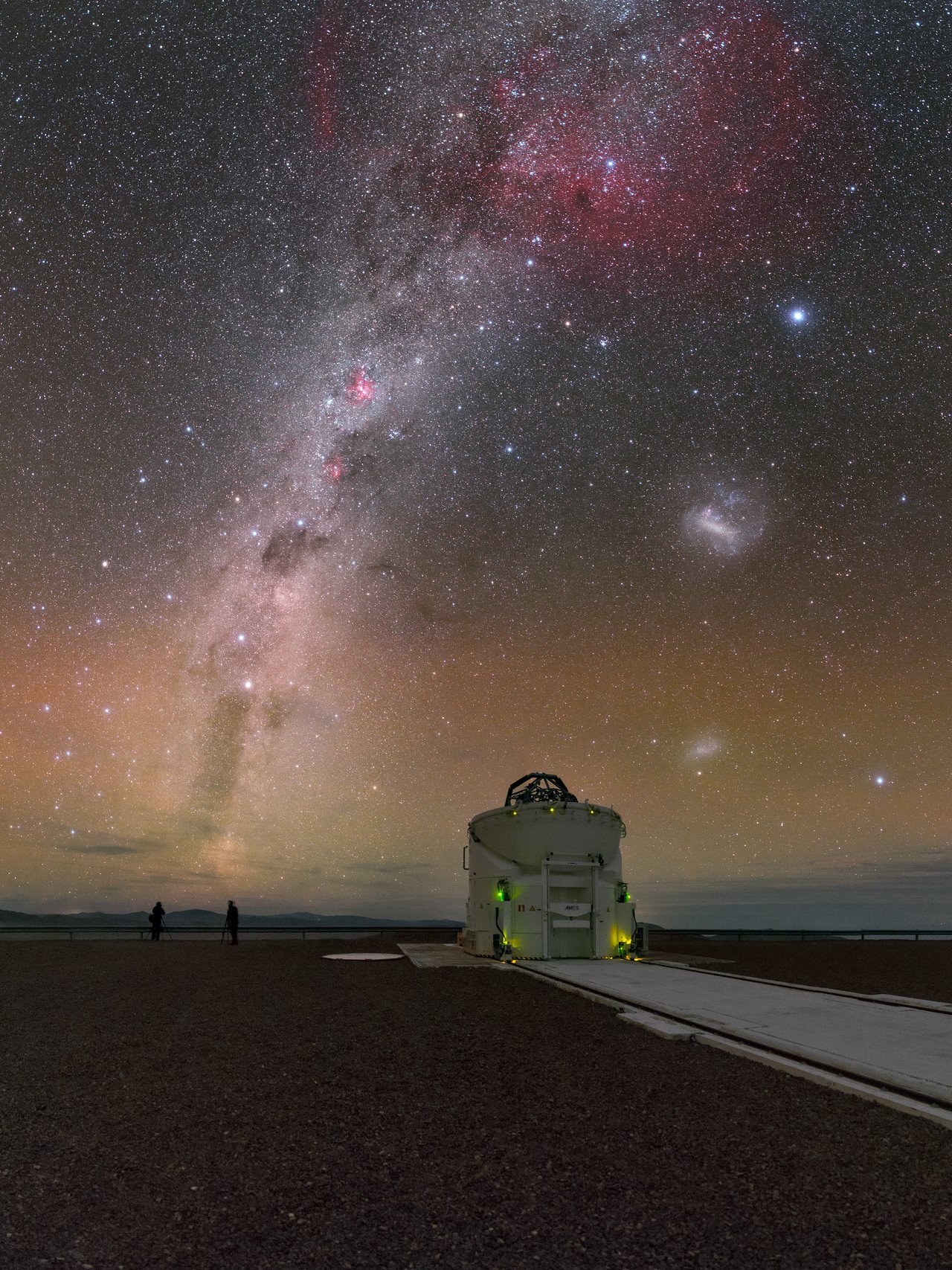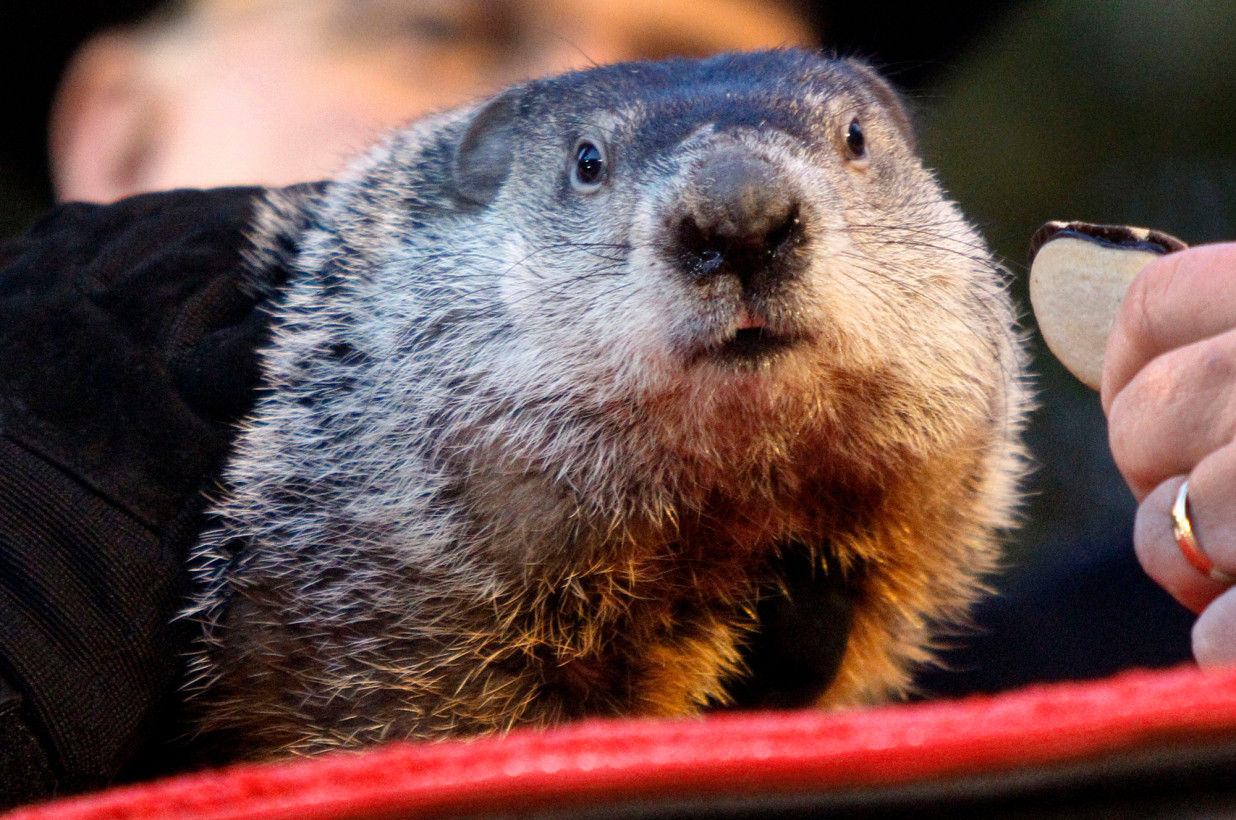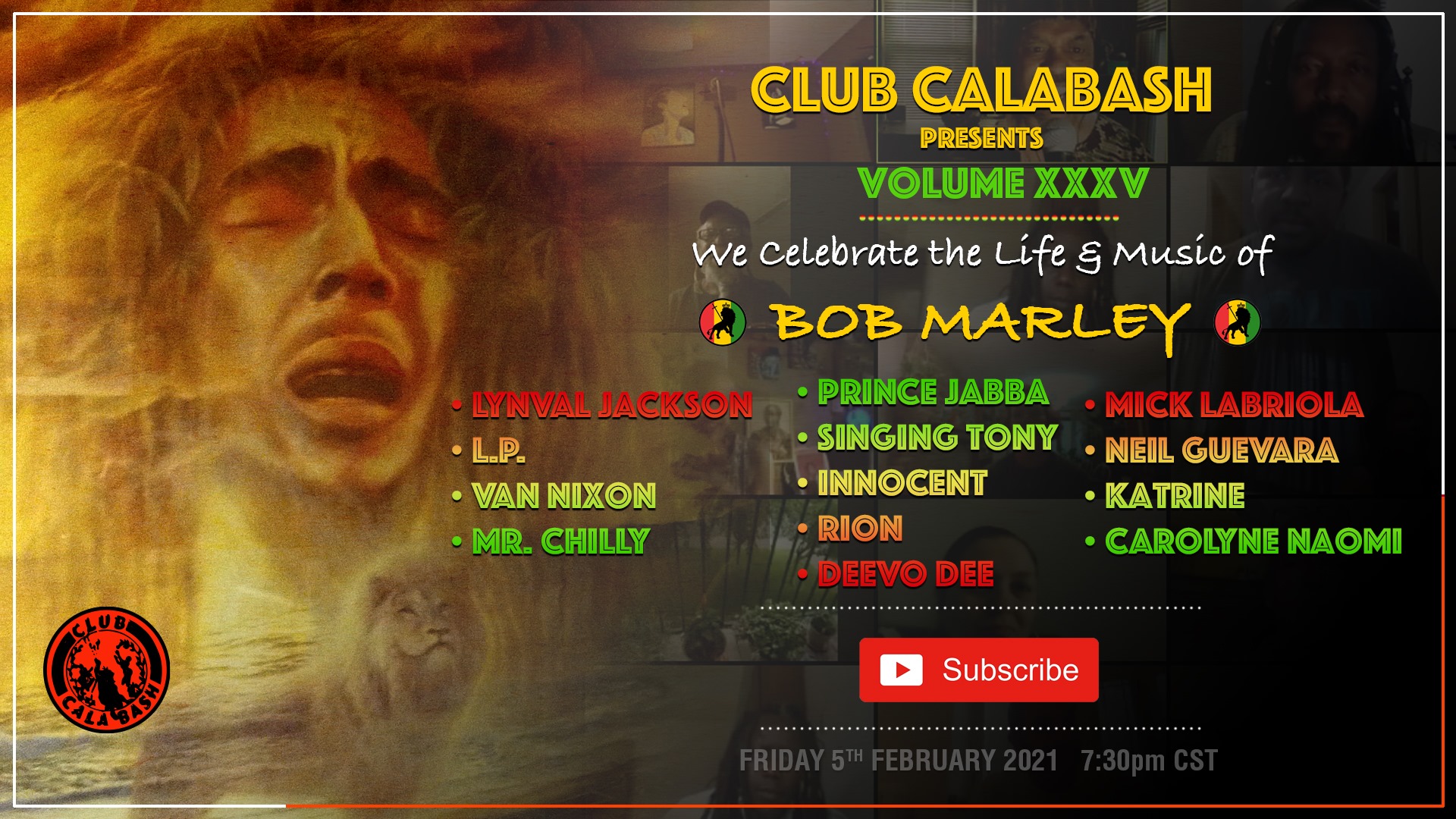Blog
This beautiful photograph of the southern sky was taken by ESO Photo Ambassador Petr Horálek from ESO’s Paranal Observatory in Chile. Petr was not alone at Paranal. Standing to the bottom left of the image, next to an Auxiliary Telescope of the Very Large Telescope Interferometer (VLTI), are astrophotographers Yuri Beletsky and Babak Tafreshi, both of whom are also Photo Ambassadors for ESO. The duo are seen beneath a sky filled with stunning phenomena.
The bright, dominant band of the Milky Way cuts across the sky, with the Gum Nebula (Gum 12) appearing at the top of the frame in red. The Large Magellanic Cloud, a satellite galaxy of the Milky Way, is an especially bright blotch to the centre right — just below Canopus, the brightest star in both this view and the southern constellation of Carina. A beautiful green and reddish shimmer is also visible at the bottom of the image, seemingly rising up from the horizon. This phenomenon is known as airglow and consists of faint light emitted by the Earth’s atmosphere. Airglow prevents the night sky from being completely dark, and is explained in detail in ESOcast 78.

Bobby Durham (February 3, 1937 – July 6, 2008) was an American jazz drummer.
Durham was born in Philadelphia and learned to play drums while a child. He played with The Orioles at age 16, and was in a military band between 1956 and 1959. After his discharge he played with King James and Stan Hunter. In 1960 he moved to New York City, where he played with Lloyd Price, Wild Bill Davis, Lionel Hampton, Count Basie, Slide Hampton, Grant Green, Sweets Edison, Tommy Flanagan, Jimmy Rowles, and the Duke Ellington Orchestra, in which he played for five months. While working with Basie he met Al Grey, and was a member of several of Grey’s small ensembles. He accompanied Ella Fitzgerald for more than a decade, and worked with Oscar Peterson in a trio setting.
Durham also played in trios with organists such as Charles Earland and Shirley Scott, and there was a resurgence in interest in Durham’s work during the acid jazz upswing in the 1990s. Many of Durham’s projects, both as sideman and as leader, have come due to his association with producer Norman Granz, who had him work with Ella Fitzgerald, Count Basie, Harry Edison, Flanagan, and Joe Pass. Durham has led his own combos as well; he is noted for scat singing along with his drum solos. Durham has also performed often with pop and soul musicians such as Frank Sinatra, James Brown, Ray Charles, and Marvin Gaye.
He died of lung cancer in Genoa, Italy, aged 71.
more...John Watson Jr. (February 3, 1935 – May 17, 1996), known professionally as Johnny “Guitar” Watson, was an American blues, soul, and funkmusician and singer-songwriter. A flamboyant showman and electric guitarist in the style of T-Bone Walker, Watson recorded throughout the 1950s and 1960s with some success. His creative reinvention in the 1970s with funk overtones, saw Watson have hits with “Ain’t That a Bitch” and “Superman Lover”. His successful recording career spanned forty years, with his highest chart appearance being the 1977 song “A Real Mother for Ya”. Watson was born in Houston, Texas. His father John Sr. was a pianist, and taught his son the instrument. But young Watson was immediately attracted to the sound of the guitar, in particular the electric guitar as played by T-Bone Walker and Clarence “Gatemouth” Brown.
more...Lillian Hardin Armstrong (née Hardin; February 3, 1898 – August 27, 1971) was a jazz pianist, composer, arranger, singer, and bandleader. She was the second wife of Louis Armstrong, with whom she collaborated on many recordings in the 1920s.
Her compositions include “Struttin’ with Some Barbecue“, “Don’t Jive Me”, “Two Deuces”, “Knee Drops”, “Doin’ the Suzie-Q”, “Just for a Thrill” (which was a hit when revived by Ray Charles in 1959), “Clip Joint”, and “Bad Boy” (a hit for Ringo Starr in 1978). Armstrong was inducted into the Memphis Music Hall of Fame in 2014. She was born Lillian Hardin in Memphis, Tennessee, where she grew up in a household with her grandmother, Priscilla Martin, a former slave from near Oxford, Mississippi.
more...I had the pleasure of working with Flory years ago with Voices of Sepharad. She was a wonderful inspiration and dedicated songwriter and singer. Have a great new adventure Flory.
Jagoda Flory Jagoda Beloved “Nona” Flory Jagoda, 97, died peacefully on January 29, 2021 at Silverado Alexandria Memory Care Community. Peaceful and strong-spirited, that’s how Flory Jagoda’s daughters Betty and Lori would like her to be remembered. Flory Jagoda is a Bosnian-Jewish born guitarist, composer and singer-songwriter. She comes from a centuries-old tradition with roots in the Iberian Peninsula, and is the last remaining member of the Altaras family lineage. Her family was one of many Sephardic Jewish families forced to flee Spain and Portugal in the 14th and 15th centuries, eventually settling in Sarajevo. Jagoda’s life story is also marked by resettlement and fleeing. Escaping Nazi persecution, she finally put down her roots in the United States after World War II. Jagoda is known for her interpretation of Ladino (Judeo-Spanish) songs and sevdalinka (Bosnian folk ballads). In 2002, Flory Jagoda received a National Heritage Fellowship from the National Endowment for the Arts, the highest honor given to artists in the United States. Now 95 and suffering from advanced dementia, Jagoda relies on her children to tell her story. Her daughters, Lori and Betty, sat down with Oslobodjenje to speak about their mother’s contributions to the arts and Sephardic music, and her deep love for Bosnia and Herzegovina.
more...Meteors can be colorful. While the human eye usually cannot discern many colors, cameras often can. Pictured is a Quadrantids meteor captured by camera over Missouri, USA, early this month that was not only impressively bright, but colorful. The radiant grit, likely cast off by asteroid 2003 EH1, blazed a path across Earth’s atmosphere. Colors in meteors usually originate from ionized elements released as the meteordisintegrates, with blue-green typically originating from magnesium, calcium radiating violet, and nickel glowing green. Red, however, typically originates from energized nitrogen and oxygen in the Earth’s atmosphere. This bright meteoric fireball was gone in a flash — less than a second — but it left a wind-blown ionization trail that remained visible for several minutes.

Alphonso Johnson (born 2 February 1951) is an American jazz bassist active since the early 1970s. Johnson was a member of the influential jazz fusion group Weather Report from 1973 to 1975, and has performed and recorded with numerous high-profile rock and jazz acts including Santana, Phil Collins, members of the Grateful Dead, and Chet Baker.
Born in Philadelphia, Pennsylvania, Johnson started off as an upright bass player, but switched to the electric bass in his late teens. Beginning his career in the early 1970s, Johnson showed innovation and fluidity on the electric bass. He sessioned with a few jazz musicians before landing a job with Weather Report, taking over for co-founding member Miroslav Vitous. Johnson debuted with Weather Report on the album Mysterious Traveller. He appeared on two more Weather Report albums: Tale Spinnin’ (1975) and Black Market (1976) before he left the band to work with drummer Billy Cobham. During 1976-77 he recorded three solo albums as a band leader, for the Epic label, in a fusion-funk vein.
more...Graham William Nash OBE (born 2 February 1942) is a British-American singer-songwriter and musician. Nash is known for his light tenor voice and for his songwriting contributions as a member of the English pop/rock group the Hollies and the folk-rock supergroup Crosby, Stills & Nash. Nash became an American citizen on 14 August 1978 and holds dual citizenship with the United Kingdom and the United States.
Nash is a photography collector and a published photographer. He was inducted into the Rock and Roll Hall of Fame as a member of Crosby, Stills & Nash in 1997 and as a member of the Hollies in 2010.
Nash was appointed an Officer of the Order of the British Empire (OBE) in the 2010 Birthday Honours List for services to music and to charity.
Nash holds four honorary doctorates, including one from New York Institute of Technology, one in Music from the University of Salford in 2011 and his latest Doctorate in Fine Arts from Lesley University in Cambridge, Massachusetts
more...Stanley Getz (February 2, 1927 – June 6, 1991) was an American jazz saxophonist, professionally known as Stan Getz. Playing primarily the tenor saxophone, Getz was known as “The Sound” because of his warm, lyrical tone, his prime influence being the wispy, mellow timbre of his idol, Lester Young. Coming to prominence in the late 1940s with Woody Herman‘s big band, Getz is described by critic Scott Yanow as “one of the all-time great tenor saxophonists”. Getz performed in bebop and cool jazz groups. Influenced by João Gilberto and Antônio Carlos Jobim, he popularized bossa nova in America with the hit single “The Girl from Ipanema” (1964).
Stan Getz was born on February 2, 1927, at St. Vincent’s Hospital in Philadelphia, Pennsylvania, United States. Getz’s father Al was born in Mile End, London, in 1904, while his mother Goldie (née Yampolsky) was born in Philadelphia in 1907. His paternal grandparents Harris and Beckie Gayetski were originally from the Kiev area of the Russian Empire (now Ukraine) but had migrated to escape the anti-Jewish pogroms in the Russian Empire to Whitechapel, in the East End of London. There, they owned the Harris Tailor Shop at 52 Oxford Street for more than 13 years. In 1913, Harris and Beckie emigrated to the United States with their three sons Al, Phil, and Ben, following their son Louis Gayetski who had emigrated to the US the year before.
https://www.youtube.com/watch?v=MJC1JPdqGRw&t=638s
more...Edward Hammond Boatner Jr. (February 2, 1924 – July 22, 1982), known professionally as Sonny Stitt, was an American jazz saxophonist of the bebop/hard bop idiom. Known for his warm tone, he was one of the best-documented saxophonists of his generation, recording more than 100 albums. He was nicknamed the “Lone Wolf” by jazz critic Dan Morgenstern because of his relentless touring and devotion to jazz. Stitt was sometimes viewed as a Charlie Parker mimic, especially earlier in his career, but gradually came to develop his own sound and style, particularly when performing on tenor saxophone.
Edward Hammond Boatner, Jr. was born in Boston, Massachusetts and grew up in Saginaw, Michigan. He had a musical background: his father, Edward Boatner, was a baritone singer, composer, and college music professor; his brother was a classically trained pianist, and his mother was a piano teacher. He was given up for adoption in 1924 by his father and adopted by the Stitt family in Saginaw. He later began calling himself “Sonny”. While in high school in Saginaw, he played in the Len Francke Band, a local popular swing band.
more...James Ambrose Johnson Jr. (February 1, 1948 – August 6, 2004), better known by his stage name Rick James, was an American singer-songwriter, multi-instrumentalist and record producer. Born and raised in Buffalo, New York, James began his musical career in his teen years. He was in various bands before entering the U.S. Navy to avoid being drafted into the army. In 1964, James deserted to Toronto, Canada, where he formed the rock band the Mynah Birds, who eventually signed a recording deal with Motown Records in 1966.
more...More Posts
- Trio Mandili
- Daily Roots Tommy McCook
- Echos of Freedom Malcom X
- Lost Souls
- Peace & War
- Joe Khoury Memorial
- Obama Truth
- Betty LaVette
- Happy Chinese Lunar New Year 2025
- Cosmo NGC 3718/29
- Beverly Kenney
- James Jameson
- Ed Shaughnessy
- World Music Shirley Collins
- Daily Roots Roots Radics
- Cosmo HFG1
- King Tubby
- Ronnie Scott
- John Williams
- World Percussion Mohamed Bangoura

